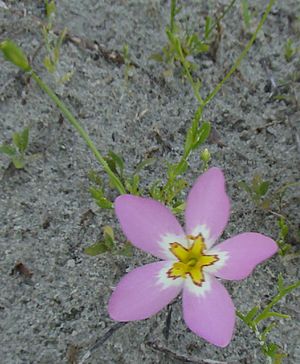Sabatia stellaris facts for kids
Quick facts for kids Sabatia stellaris |
|
|---|---|
 |
|
| Marsh pink (Sabatia stellaris) on Fripp Island, South Carolina | |
| Scientific classification | |
| Genus: |
Sabatia
|
| Species: |
stellaris
|
The Marsh Pink (Sabatia stellaris) is a beautiful wild flower. It is also known by other names like Rose of Plymouth or Sea-Pink. This plant is a type of Sabatia flower. It's a special plant that grows in certain parts of the United States.
Contents
Where Does the Marsh Pink Live?
The Marsh Pink plant is found only in the Eastern United States. It grows along the Atlantic and Gulf coasts. You can find it from Massachusetts all the way down to Florida. It also grows west into Louisiana.
This plant loves salty places! It is a halophyte, which means it can grow in salty soil. You will mostly find it in salt marsh areas. However, it faces a challenge from a plant called Phragmites australis. This plant is an invasive species, meaning it spreads quickly and can take over the Marsh Pink's habitat.
What Does the Marsh Pink Look Like?
The Marsh Pink is an annual plant. This means it lives for only one growing season. In the northern parts of its range, it grows about 20 centimeters (about 8 inches) tall. But in the warmer southern areas, it can grow up to 50 centimeters (about 20 inches) tall.
Marsh Pink Leaves
The leaves of the Marsh Pink grow in pairs, one across from the other. Their shape can be narrow or wide. Plants in Florida tend to have narrow leaves. Those in New England have wider leaves. The leaf shape changes gradually from north to south. Scientists call this a clinal change. It means there aren't clear types of leaves, just a smooth change.
Marsh Pink Flowers
The flowers of the Marsh Pink are very pretty. They can be pink or white. Each flower has five or six petals, which are called corolla lobes.
Marsh Pink Seeds and Life Cycle
After the flower blooms, it produces a dry capsule. This capsule is like a small box. Inside, it holds many tiny seeds. A single capsule can contain up to 600 seeds! These seeds help the plant make new Marsh Pinks for the next year.
Is the Marsh Pink in Danger?
Yes, the Marsh Pink needs our help in some places. It is listed as an endangered plant in several states. This means there are not many of them left in these areas. It is endangered in Massachusetts, Connecticut, and New York. Protecting their salty marsh homes is important to help these beautiful flowers survive.

